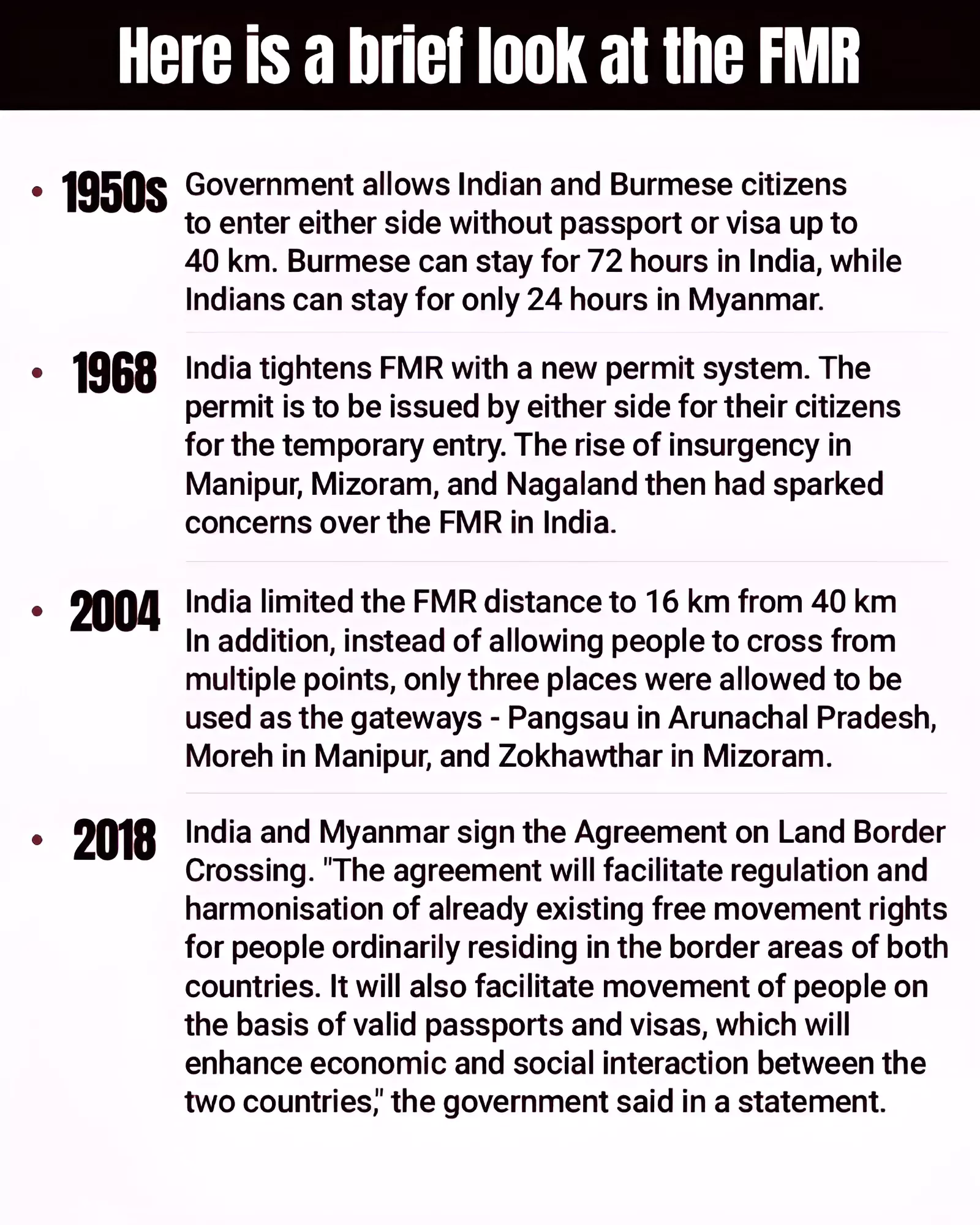Context:
The Union Home Minister recently indicated that the Centre has decided to fence the entire length of the India Myanmar border to stop people’s free movement.
India Myanmar Border
- The border between India and Myanmar runs for 1,643 km in the four states of Mizoram, Manipur, Nagaland, and Arunachal Pradesh
- It is an Open Border that runs through forested and undulating terrain, it is almost entirely unfenced, and is difficult to monitor.
- In Manipur, less than 6 km of the border is fenced.
What is the Free Movement Regime on the India-Myanmar Border?

- Definition: The Free Movement Regime is a mutually agreed arrangement between the two countries that allows tribes living along the border on either side to travel up to 16 km inside the other country without a visa.
- Implementation: It was implemented in 2018 as part of the government’s Act East policy.
Future of Free Movement Regime (FMR) and Border Management:
- Balancing Security and Local Needs: Experts doubt its effectiveness without proper border security and enforcement. They suggest regulating FMR rather than complete removal or fencing the entire border.
- Manipur’s suspension of the FMR since 2022 hasn’t significantly altered the situation.
- Alternatives to FMR: Improved border management, intelligence gathering, and addressing the root causes of migration in Myanmar are crucial.
- Bilateral Cooperation: Collaboration with Myanmar is essential for effective border management and tackling shared security challenges.
Free Movement Regime (FMR) Rationale and Benefits
- Historical Divide: The British demarcated the border between India and Myanmar in 1826, without seeking the people’s opinion in the region. The border effectively divided people of the same ethnicity and culture into two nations without their consent.
- Facilitating Cultural and Economic Ties: FMR allows border communities to maintain relationships and engage in cross-border trade.
- People in the region have strong ethnic and familial ties across the border. In Manipur’s Moreh region, there are villages where some homes are in Myanmar.
- In Nagaland’s Mon district, the border passes through the house of the chief of Longwa village, splitting his home into two.
- Local trade and business: It was supposed to provide impetus to local trade and business. The region has a long history of trans-border commerce through customs and border haats.
- Given the low-income economy, such exchanges are vital for sustaining local livelihoods.
- Boosting Regional Ties: FMR was part of India’s Act East policy to strengthen relations with Myanmar.
- For border people in Myanmar too, Indian towns are closer to business, education, and healthcare than those in their own country.
Why is the Free Movement Regime (FMR) Being Scrapped?
The Indian Government blames the Free Movement Regime (FMR) for;
- Illegal Immigration: FMR has been blamed for facilitating illegal migration from Myanmar, particularly during the recent crisis.
- The illegal migration of tribal Kuki-Chin peoples into India from Myanmar is one of the key issues in the ongoing Manipur conflict.
- Drug Trafficking and Terrorism: Concerns exist that porous borders and misuse of FMR enable smuggling and insurgent activities.
- Security Concerns: The long, unfenced border presents challenges for border control and national security.
Opposition to scrapping the Free Movement Regime (FMR):
- Mizoram and Nagaland argue the FMR preserves vital ethnic and economic ties across the border.
- They view fencing the border as unacceptable due to its colonial origins dividing communities.
Also Read: Instability In Myanmar And Its Impact On India
Conclusion
The India-Myanmar border presents complex challenges. Balancing security concerns with the needs of local communities and regional relations requires a nuanced approach that goes beyond simply building fences or scrapping existing agreements.
Also Read:
News Source: Indian Express
![]() 22 Jan 2024
22 Jan 2024
